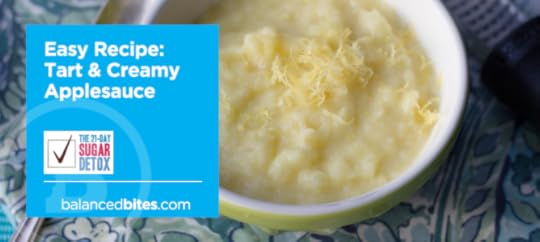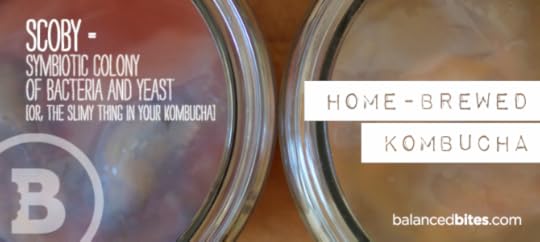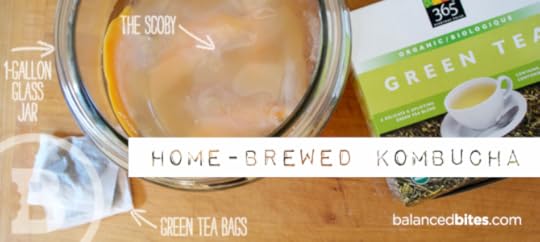Diane Sanfilippo's Blog, page 75
December 20, 2012
Podcast Episode #66: The 21-Day Sugar Detox – FAQs and questions answered!

Remember – If you’re enjoying these podcasts, please leave us a review in iTunes. Thanks!
Episode #66: The 21-Day Sugar Detox – FAQs and questions answered!
UPCOMING EVENTS: The Balanced Bites Workshop with Diane & Liz!
Saturday, January 19, 2013 | Los Angeles, CA
9am-5pm at DogTown CrossFit
Click here to register.
Sunday, January 20, 2013 | San Diego, CA
9am-5pm at CrossFit Elysium
Click here to register.
NEW! Sunday, March 9, 2013 | Washington, DC
9am-5pm at CrossFit Metro Center
Click here to register.
Remember that all events are open to the public, you do not need to belong to the hosting gym to attend!
Opening chat:
Updates from Diane & Liz.
Topics:
Intro to The 21-Day Sugar Detox [15:40]
1. Can I use vinegars like balsamic, apple cider, etc.? [18:00]
2. What can I substitute for my gum/mints? [21:42]
3. I’m super hungry – is this normal? What should I do? [26:00]
4. Is becoming extra cranky normal? [29:45]
5. Clarification of who is considered an “athlete” for modification of The 21-Day Sugar Detox standard Yes/No list. [32:10]
6. Why can we have a green apple or free-tipped banana but no berries (which have lower sugar content)? [35:15]
7. Can I participate in The 21-Day Sugar Detox on a vegetarian diet? [39:50]
8. Can I sweeten my coffee, and if so, with what? [43:32]
9. What if some of the foods on the “yes” list have sugar on the label (ex: cheese shows 1 g of sugar, bacon ect.)…is that ok? [50:00]
10. What can I do to keep from going ballistic on sweets on day 22?…again. [55:50]
LINKS:
Click here to download this episode as an MP3.
The episodes are currently available in iTunes, Stitcher & Blog Talk Radio.
Click here to submit questions.
Cheers!
Diane & Liz
December 17, 2012
Easy Recipe: Tart & Creamy Applesauce
I first made this recipe as part of the content development for my original The 21-Day Sugar Detox program manual back in early 2010. Wow, time flies! I have updated the guides many times since then, but this recipe and (ahem) the photos, were a bit behind-the-times.
So, just in time for the biggest group of 21DSDers ever launching January 1, 2013…
Here’s a fresh take on a delicious way to make applesauce that’ll surprise your taste buds with its tartness but delight you with it’s creamy texture. Enjoy!
tart & creamy applesauce
grain-free • gluten-free • sugar-free • nut-free • nightshade-free • 21DSD
PREP TIME: 10 minutes
COOKING TIME: 30 minutes
YIELD: 8 servings
NUTRITION INFO: coming soon
ingredients:
8 green apples, peeled and chopped into 1/2″ pieces
1/2 cup of butter
2 lemons, juice & zest
preparation:
In an enameled cast iron or stainless steel pot over medium heat simmer the apples, lemon juice, lemon zest and butter together until the fruit is soft – approx 15-20 minutes.
Mash or puree the apples to whatever texture you like, or leave it chunky.
Serve warm or at room temperature. It will solidify a bit as it cools.
make it awesome:
Top with chopped walnuts or almonds for crunch and some added protein and fat.
Serve over chicken or pork or enjoy as a snack.
Yes, you can enjoy this recipe while on the 21-Day Sugar Detox.
For more The 21-Day Sugar Detox friendly recipes, check out The Food Lovers Kitchen, Chowstalker, and The Foodee.
Note: I earn a small commission if you use the links in this post to purchase the products mentioned. I only recommend products I would use myself or that I recommend for clients in my practice or at workshops. Your purchase helps support my work in bringing you real information about nutrition and health.
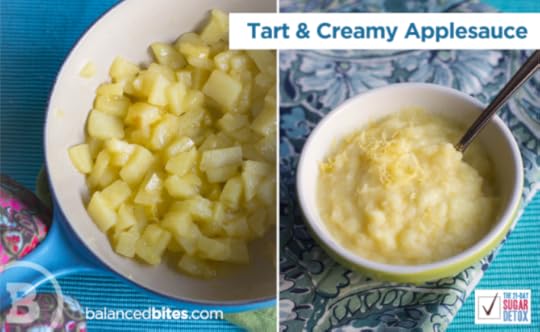
December 13, 2012
Podcast Episode #65: Wild fish, probiotics, cancer & rosacea

Remember – If you’re enjoying these podcasts, please leave us a review in iTunes. Thanks!
Episode #65: Wild fish, probiotics, cancer & rosacea
UPCOMING EVENTS: The Balanced Bites Workshop with Diane & Liz!
Saturday, January 19, 2013 | Los Angeles, CA
9am-5pm at DogTown CrossFit
Click here to register.
Sunday, January 20, 2013 | San Diego, CA
9am-5pm at CrossFit Elysium
Click here to register.
Remember that all events are open to the public, you do not need to belong to the hosting gym to attend!
Opening chat:
CleanEatsSF Kickstarter! Help to fund a Paleo kitchen/hub for San Francisco and the Bay Area – learn more here.
Upcoming workshops, Liz’s skin care guide, Diane’s new Autoimmune Paleo Recipes eBook, updates to The 21-Day Sugar Detox…
Topics:
1. Bone broth fat – eat it or not? [13:10]
2. How much FCLO (fermented cod liver oil) for kids? [20:45]
3. Farm raised vs wild fish [24:05]
4. What to do when I can’t get down fermented foods? [31:00]
5. Grass-fed beef a no-go for cancer patients? If so, why? [38:18]
6. Rosacea [42:30]
LINKS:
Food quality labeling – fish
Bio-Kult
Dr. Ron’s Soil-based organism probiotic
Dr. Ron’s Smooth Operator
Click here to download this episode as an MP3.
The episodes are currently available in iTunes, Stitcher & Blog Talk Radio.
1. Bone Broth Fat – Eat it or not?
Jennifer says,
I just finished your book and loved it so much I bought one for my parents who have never quite understood paleo and how to shop/eat but now they will after getting your book! Your broth recipe you say to trim the fat off the top once it’s cooled. I used to do this all the time but since going paleo I leave it now. Is it better for me to take it off?
2. How much FCLO for kids?
Jamie says,
I absolutely love Practical Paleo and have learned a lot from it. I personally have been told I have a leaky guy and my husband has spinal cord injury, so we are careful with our nutrition to help us both. We also have a 2 year old who started us on the path to Paleo (how we now eat, (me 100%, my son 95%, my husband 85% or so…) after he started having eczema as a baby. I have incorporated the FCLO into our diets which has helped a lot but I was wondering what the correct portion for us should be. I have been doing an unmeasured 1/2 tsp and about 1/8 tsp for my son, but wasn’t totally sure what was appropriate.
3. Farm raised vs wild fish
Joe says,
In the book ‘Practical Paleo’ definitions are given for seafood and what the packaging means. I was surprised to read the definition of wild-caught. However looking into this label some more I’ve only been able to find the distinction of farm raised vs wild fish; where wild-fish and wild-caught are used interchangeably. Can you elaborate on this more?
4. What to do when I can’t get down fermented foods?
Jenna says,
How do I choose a probiotic supplement? I have tried to eat or drink probiotics but sadly every form except yogurt (and I don’t tolerate dairy well) makes me want to vomit just smelling it. (I also have a VERY negative reaction to vinegars in almost all forms and avoid them at all costs) breakfast is typically eggs with homemade sausage and some type of veggie (spinach & mushrooms are the most frequent at the moment). Lunch, whatever leftovers I find in the fridge. Dinner, meat of some kind usually with 2 veggies (spinach, cauliflower, broccoli, squash, sweet potato … ). I had recently been having too many treats and am just about to finish up my first sugar detox, hopefully I’ll be able to keep those in check now (just a handful of times a month instead of a few times a week).
I typically sleep 7-8 hours a night, never had any issues there. Unfortunately due to a back injury I am not able to workout much at the moment and have really fallen off the bandwagon on that one though I am looking forward to lifting again when I’m all healed up.
5. Grass-fed beef a no-go for Cancer Patients? iI so why?
Dawn says,
Hi Diane and Liz, I am reading Practical Paleo and I think it is destined to be a paleo classic. I have been eating paleo for several months now. My husband was NOT interested until he developed some abdominal pain last month and was diagnosed with lymphoma. He is about to start chemo. Luckily, the lymphoma was caught early and the prognosis for remission is very, very good. Interestingly, he eats a lot of grains (he follows a macrobiotic food plan which includes meat and fish) and the swollen lymph nodes are mainly centered around his small and large and intestine. Based on the info in your book, we are wondering if the lymphoma might be a consequence of long term leaky gut.
My question is regarding the section on Cancer recovery, which we have a keen interest in for obvious reasons. We have avidly read that section (several times) as well as the 30 day meal plans. I noticed that grass fed/grass finished beef is not on the list of recommended foods or even used in the 30 day meal plan. Is grass fed beef detrimental to those with any type of cancer?
Thanks for your help.
Click here to submit questions.
Cheers!
Diane & Liz
December 12, 2012
Balanced Bites Workshops 2013: Los Angeles & San Diego, CA
More Winter & Spring 2013 dates are coming soon, so stay tuned to the Balanced Bites podcast, newsletters, Facebook, and Twitter, and follow the right-hand sidebar of the site for the latest information. Our early 2013 openings are limited at this point but we are still accepting requests, so please contact us if you would like to host an event.
Liz Wolfe, Nutritional Therapy Practitioner and author of the hilarious blog Cave Girl Eats (and the upcoming book Modern Cave Girl) and I teach the workshops together – so you get double the fun!
All events are open to the public, you don’t need to be a member of the hosting gym to attend.

Saturday, January 19, 2013 | Los Angeles, CA
9am-5pm at DogTown CrossFit
Open to the public.
Click here to register.
Sunday, January 20, 2013 | San Diego, CA
9am-5pm at CrossFit Elysium
Open to the public.
Click here to register.
Click here to read more details about the workshops.
Click here to read testimonials about Balanced Bites workshops.
Hope to see you soon!
December 9, 2012
Paleo Recipes for Autoimmune Conditions
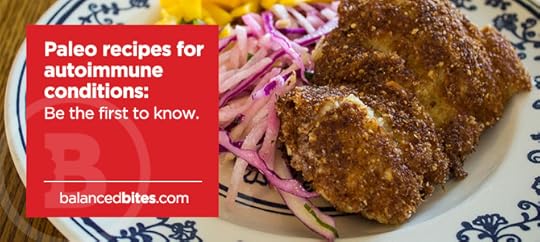
Since the release of Practical Paleo, the response to the section on eating for autoimmune conditions has been overwhelming. By popular demand, I am developing a downloadable cookbook with brand new autoimmune-friendly recipes, more meal plans, and tips for following this difficult way of healing your body through food. We asked you to tell us what type of recipes you’d like to see and over 600 of you responded! We were so excited for all the feedback, and the e-cookbook is almost ready!
Be the first to know
Want to be the first to know when the new downloadable cookbook of paleo recipes for autoimmune conditions drops? It’s coming very soon! Enter your email address into the form below and we’ll let you know when the new cookbook is available.
Get 3 free autoimmune-friendly paleo recipes
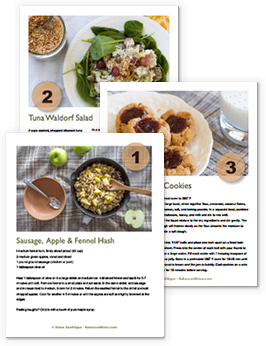
When you sign up, you’ll receive a PDF with 3 free autoimmune-friendly recipes so you can get a little teaser of what the cookbook will be like!
Sausage, Apple & Fennel Hash - great for breakfast
Tuna Waldorf Salad - an easy and healthy lunch for on the go
Jam Thumbprint Cookies - a grain, nut, dairy, egg-free take on this old fashioned favorite
Don’t miss out on this!
Sign up here
December 6, 2012
Podcast Episode #64: Surviving the holidays – indulging, family & cocktails!

Remember – If you’re enjoying these podcasts, please leave us a review in iTunes. Thanks!
Episode #64: Surviving the holidays – indulging, family & cocktails!
Upcoming Events:
Balanced Bites Workshops
NEW! Sunday, January 20 – San Diego, CA – get details and register here.
More 2013 schedule coming soon!
Remember that all events are open to the public, you do not need to belong to the hosting gym to attend!
Opening chat: Overall mindset when it comes to eating around the holidays
Topics:
1. How do I stay on the wagon? [12:24]
2. Best time to eat sweets? [25:37]
3. & 4. Recovery after indulgences [29:39 & 33:20]
5. How to handle judgment from family [39:19]
6. Paleo-friendly holiday cocktails [44:45]
7. Keeping up with fitness routine during the holidays [48:45]
Click here to download this episode as an MP3.
The episodes are currently available in iTunes, Stitcher & Blog Talk Radio.
1. How do I stay on the wagon?
Juni Says,
First off—Love the podcast AND Diane’s snazzy new hairdo on the website! Hello!? I walk on my lunch break and listen to this podcast. It is the best part of my work day. Thank you!
I have been on and off a Paleo way of eating since January of 2012. I feel like I fall off the wagon when I get caught in a bad way of thinking that goes something like this: “why can’t I eat like normal people and really, how bad can it be for me if everyone still eats all this stuff on a regular basis?” “Why was I able to reach weight goals easier while eating a “clean” non-Paleo diet?” “I’m sick of having to tell people that I CAN’T eat this or that”. I also think I suffer from selective amnesia (I say jokingly) as there are tons of little symptoms that go away when I eat Paleo that I seem to forget about when I am feeling sorry for myself. To make a long story short, I know unequivocably, through these recent “Return to SAD” experiments that I feel MUCH better when I eat a Paleo diet. I know that in having an Autoimmune disorder (Hashimoto’s) that very real symptoms of me being intolerant of non-Paleo foods are present. I know that my previous weight goals were more motivated by vanity and may not be as healthy as I thought they were. I know that no matter how simply the Paleo diet is laid out that a great deal of personal tweaks must be made to find the right formula for an individual. I know, I know, I know….but why do I still fight this?
Diane has mentioned a few times that when trying to get off gluten that it took her about a year to really do it. I’d love to hear her elaborate on this story and what it was that finally made her give it up for real. I’ve read the Introduction to Practical Paleo (and love the book) so I know her story in general but would like to hear more about the ways she’d fall off the wagon, get back on again and ultimately found the strength to say “I’m at peace with living in a way that is best for me”. Maybe you both could share some anecdotes about how your clients have made the transition from partial to fully committed. Or maybe you’ll tell me that I need to chill and just take things as they come? Either way, can you address the emotional/psychological aspects of major dietary changes like this?
2. Best time to eat sweets?
Stacey says,
heard eating sugar after a meal is the best way to minimize blood sugar spikes if you choose to indulge. Is that true? Is there a better time to eat sweets?
3. & 4. Recovery after indulgences?
Hope says,
OK, I did a BIG no-no and ate stuffing and pie over Thanksgiving and now of course I feel like poo…. I’ve stopped eating yucko stuff which is helping, but anything I can do to speed along my feeling better?
Dave says,
I’ve been recently diagnosed with celiac and a leaky gut. I just finished the elimination diet and I’m starting to reintroduce foods on a weekly basis. On occasion, the rigors of modern life force me to eat out. About half the time I come away feeling some pain and/or discomfort which I chalk up to some gluten getting into my food either through cross contamination, something in the food (like a sausage). I am loath to go back on the elimination diet, so I’m worried that these instances might again lead to a leaky gut. How much exposure does it take and over what time period? What kind of symptoms should I be on the watch for should I suspect something?
My wife and I love your book. We bought 4. one for us, one for each of our exes, and another for my mother-in-law. All so, our kids can eat as healthy with them as they do when they’re with us. Keep up the great work!
5. How to handle judgment from family
Leslie says,
My question is as to the feelings of judgement on behalf of family members. First, as someone with Celiac, I struggle during the holiday season at family gatherings. Second, as someone who as embraced a Paleo lifestyle (which has been extremely life changing for my PCOS and food allergies), it is alienating to be surrounded by the average American eaters. Advice?
6. Paleo-friendly holiday cocktails
Andrada says,
What are the best & most Paleo friendly cocktails & wines. I read that some wines can have gluten b/c a wheat paste is sometimes used to seal the barrels. Which is better gin, vodka, tequila, etc in terms of doing the least amount of damage to the gut? Thanks!
7. Keeping up with fitness routine during the holidays
Lauren says,
What and how to maintain fitness levels when the weather, holiday schedules, and life get in the way of exercise? Thanks!
Click here to submit questions.
Cheers!
Diane & Liz
December 4, 2012
Easy Recipe: Home-Brewed Kombucha
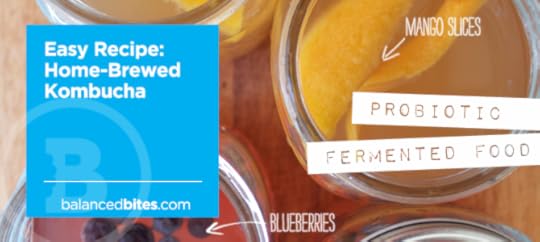
The first time I tried kombucha was in 2007.
I was working at Lululemon Athletica part-time in San Francisco while I was working on the business plan for Balanced Bites – originally a grass-fed/organic meal delivery business. Yes, really. One of the many cool things about working at the store was that we’d get a “treat” each morning or evening if we opened or closed – especially over the holiday season when times were busy. Often we’d get items from Starbucks, but this time it was a run to the local health food shop down the street. I asked some of the other Lulus what they were getting, and most of them replied “kombucha!” Okay, well I wasn’t going to be a sore sport who didn’t try this crazy sounding drink everyone raved about. So I tried it. They recommended GT’s Synergy Mystic Mango. I took one sip and nearly choked on it. It was sour, tart, even alcoholic-tasting. I am a notoriously bad drinker.
About 5 minuter later, I felt buzzed. What the heck?! I thought this was some kind of fruity drink thing, not a cocktail?! I can’t say I was hooked from that moment, because I don’t think I even finished the whole bottle, but that was when kombucha and I first met.
Fast-forward to 2009 sitting in one of my nutrition classes learning about the benefits of fermented foods and a classmate was going on and on about how she had all these extra SCOBYs if anyone wanted one. Um, what? A what? A SCOBY [sko • bee] is a Symbiotic Colony of Bacteria and Yeast. I figured I was game as anyone for an at-home science experiment, so I took one home and did a little googling to figure out what to do with the slimy little thing.
My first batch of home-brewed kombucha was a disaster.
I didn’t have much sugar in my house at the time, and I think all I had was about 1/2 a cup of granulated muscavado. It’s dark in color, and not super appetizing once combined with the tea I brewed. Well, the fermentation went even longer than it needed to, and, with the lack of sugar in my batch, and I quickly ended up with about a gallon of weird tea-vinegar. Needless to say, I didn’t try making it again until pretty recently.
I’m lucky enough to have some awesome home-cook/home-fermenting friends these days, and one of them shipped me a SCOBY from North Carolina. SWEET. I dove right in, but this time, I followed the instructions and used the full amount of sugar called for. This is very important, folks. It ain’t like cooking or baking where you can take a lot of liberties in the way the bacteria grows on the food you provide it.
I drink kombucha regularly/daily for several reasons:
I like it. I like the taste. I like the slightly fizzy texture of it, and I like the ritual of my glass in the morning.
It has replaced my morning coffee. While I don’t need my kombucha to get me going, I certainly enjoy the caffeine-free (if I buy it from a store) or mild caffeine hit from the home-brewed green tea versions I make – as well as the B vitamins that are produced in the fermentation process.
I like food projects. Specifically ones that freak other people out, like fermented foods. So I really enjoy making my own at home and trying out new flavors (see below for a few ideas).
I enjoy the effects of the probiotic content of the tea. My digestion feels better while I’m drinking it, and unfortunately I don’t currently tolerate even grass-fed yogurt or kefir, so I’m left with other options (including my own homemade raw sauerkraut).
I feel better drinking it. I have not been sick in – knock on wood – at least a year now I don’t think. If I have been sick since then, I don’t recall it happening so it couldn’t have been that bad. And I travel a lot! We all know what kind of bugs are circulating on airplanes, but it’s not just about what bugs are around that determines whether or not someone gets sick, it’s how strong (or not!) your immune system is at crushing those bugs! Mine’s been pretty darn good at it lately. Coincidence? Perhaps… but I’m still going to drink this stuff anyway.
It’s an easy-to-find/easy-to-enjoy/socially-acceptable-and-embraced fermented food. I travel a lot, did I mention that? I find that getting my hands on some kombucha and slugging it down is a lot easier than getting some raw fermented sauerkraut and then toting the jar around until it’s finished, with or without refrigeration. Granted, I travel to lots of places where there are Whole Foods Markets, but kombucha is becoming more readily available in many other shops as well. I also find that my (now mostly Paleo) friends all pretty much are hooked as well and enjoy grabbing a bottle of the refreshing beverage together – score!
While this post is dedicated to the recipe for my raw kombucha, click here or here to read more about the health benefits of raw, fermented kombucha.


Home-Brewed Kombucha: A raw, probiotic-rich food (drink)
This is my recipe. There are many, many, many ways to make kombucha. A card was included with the SCOBY from my friend, but I don’t follow it to the letter. This is the way I’ve made it for several batches now, and I’m pleased with the results. There are parts you can modify, and parts you can’t. A lot of this is trial-and-error in my opinion, but the main things that must remain are: some kind of tea, a SCOBY, and a granulated sweetener like organic sugar. From there, you can change things up as noted below.
Yield: Approximately 1 gallon of kombucha tea.
Tools & equipment:
1-gallon or a 2-gallon glass jar or ceramic crock ahead of time. You will be able to make about 1-gallon from this recipe, but quickly will be able to make more as your SCOBY reproduces.
A SCOBY. You can either use a SCOBY that is given to you, or purchase one online from variety of sources here, here, here, or here, for example. You can also grow your own SCOBY if you can’t find one to buy or get for free from a friend. Check the comments below for a local SCOBY source! Lots of folks have them to give!
Paper towels or an old t shirt cut into a large enough piece to cover the top of your jar of kombucha while it ferments.
A large rubber band, to hold the paper towel or t-shirt onto the top of the fermenting jar to keep bugs, dust, and other critters out.
Jars for storing the tea for the second fermentation (optional) and in your fridge. I use these 32oz mason jars or I re-use bottles from store-bought kombucha.
Ingredients for the basic brew:
 64 ounces of filtered water
64 ounces of filtered water8 tea bags of your choice
I use organic green tea currently but you can use black or an herbal tea if you choose.
1 cup of sugar, granulated, I use an organic sugar - a liquid sweetener will not work
1 SCOBY, plus any liquid it was in
Note: This part does not involve imparting a specific flavoring to the tea.
Preparation:
In a large pot over high heat, boil 32 ounces of filtered water, then place the tea bags into the water to steep for 20-30 minutes.
Once the tea has completely steeped, mix in your sugar and stir it until it is dissolved completely.
Allow the sweetened tea to come to room temperature.
Once the tea has cooled, pour it into the glass jar with your SCOBY and place the jar into a cool, dark place like a cupboard or closet (I have mine in a curio cabinet covered with a towel to keep light out) for anywhere from 7-14 (or more) days. The longer the kombucha ferments, the more probiotic material is created and the less sugar remains. If it goes too far, it may become too sour or vinegar-y tasting. If this happens, you can simply add more sugar and wait for it to ferment a bit longer, or you can start over (but that would be so sad, wouldn’t it?!). It is “done” when you think it tastes how you want it to taste. It should be pretty tart/sour and not smell sweet necessarily, but it should have just a hint of sweetness left for taste. Or not, your call really.
Your kombucha is done at this point and can be bottled and refrigerated before enjoying. Or, you can go on to add fizz and/or flavor in a second fermentation process as outlined below.
To add fizz:
Once the kombucha at a desired level of tartness, or when it’s just a hint sweet still, bottle the tea into smaller containers – I typically use these 32oz mason jars. You can add a tiny bit more sugar here if you like – maybe 1/2 tsp per 32oz – before closing the jars and replace them in the dark, cool spot. [Note: If you want to flavor the tea, this is when you will do it.] Allow the tea to ferment another 5-7 (or more) days to your taste. Then refrigerate it before serving.
To keep the tea flat (no fizz):
Follow the instructions for adding fizz, but “burp” the jars every day or two to let the air out. This will keep the tea flatter. Allow the tea to ferment another 5-7 (or more) days to your taste. Then refrigerate it before serving.
To make different flavors:
Once the kombucha is at a desired level of tartness from the first round of fermentation, or when it’s just a hint sweet still, bottle the tea into smaller containers – I typically use 32oz mason jars.
Next, you can add fruit slices, whole berries, or fruit pureé in varying quantities to your taste. I will add anywhere from 1/4-1/2c of pureé per 32oz, then close the jars and replacing them in a dark, cool spot. Allow them to ferment another 5-7 (or more) days to your taste.
My favorite fruit to add: mango, blueberry, cherry, or a combination of the three. I began by adding slices and whole berries (pictured), but have progressed to adding purees. It’s really just about convenience and whatever’s easier. They both work equally well to flavor the tea in my experience. I have not yet added my own ginger or citrus, so I’m not sure on quantities of those to add. Please feel free to share your own recipes in the comments below!
Yes, you can enjoy this recipe while on the 21-Day Sugar Detox - up to 8oz per day of kombucha is allowed.
Note: I earn a small commission if you use the links in this post to purchase the products mentioned. I only recommend products I would use myself or that I recommend for clients in my practice or at workshops. Your purchase helps support my work in bringing you real information about nutrition and health.
December 3, 2012
FAQs: How can I eat Paleo without a gallbladder?
My maternal grandmother, who many of you read about in my book, has no gallbladder. My father has no gallbladder. I’ve said it many times over, when I talk about my background and motivation to study and teach nutrition, that I live and eat in a way to do the best I can to prevent not only ailments like cancer and heart disease, but also the autoimmunity that apparently is an underlying root-cause of gallbladder disease. I feel strongly that I narrowly escaped a lot of serious health concerns by changing my diet when I did. And I feel very motivated to maintain the choices that I make day-in and day-out in order to keep my current health trajectory as it has been since I kicked grains, beans, and all processed/poor quality dairy from my diet.
This post comes to you from one-half of the Dynamic Duo you’ve come to know as the Paleo Parents – Stacy Toth. Stacy is a busy mom of three with a full time job, a popular blog on parenting of Paleo kiddos, a loving wife, and a woman without a gallbladder. For those of you in the same boat – or dreading the possibility of losing your gallbladder soon – check out her take here on how to live and eat Paleo without one. This is Stacy’s perspective based on what she’s learned both in the science, and in her own n=1 experience in testing different dietary approaches on herself. Her situation is not entirely unique, but may not be exactly the same as yours. – Diane
Earlier this year I wrote a post on How to Eat Bacon without a Gallbladder. By the response the post received, there’s evidently quite a few of us who have undergone a Cholecystectomy (gallbladder removal) or know someone with Cholelithiasis (gallbladder disease). There was a cry for more information, but since I’m not a nutritionist or medical professional, I didn’t feel qualified to speak further than what’s worked for me.
Problem is, like most modern day diseases, the medical community just doesn’t get it. I appear to be one of the few voices in the paleo community who has this problem and can provide insight and recommendations – after having done a LOT of research.
Where it all began.
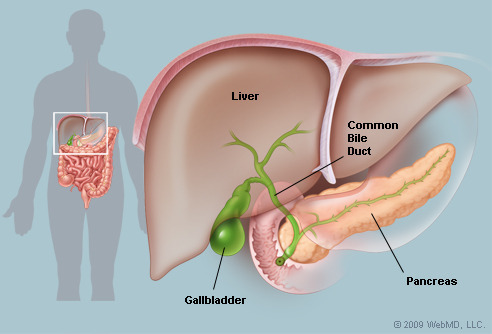
Why did I get this problem to begin with? Let’s start with the standard justifications I hear and read in the standard medical community:
A low-fat, high carb whole grain diet will solve the problem
If that doesn’t work, don’t worry – your body doesn’t need a gallbladder, removing it will solve the problem
Among the misinformation the medical professionals may or may not realize they’re telling you, the above were the worst offenders for my overall health and wellness. Despite my doctors not believing I could possibly be eating a low-fat diet, I had been for years. And despite following an extremely low fat and whole grain filled diet, my disease progressed and stones worsened. I tell a detailed health history in my earlier post – but essentially, after 7 years as a vegetarian my body was wrecked.
Was my low-fat diet making me fat and sick?
During my twenties, my weight skyrocketed. Having always been overweight, I became morbidly obese and well over 300 pounds in my early twenties. I found myself tirelessly hungry and filled with intense cravings. I realize now that this was a symptom of micronutrient malabsorption. Since I wasn’t able to digest fat or fat soluble vitamins properly, my body wasn’t able to properly digest the foods I was eating. This led me to constantly want more food in a desperate attempt to get my body the proper nutrients it needed.
This is a typical problem for those with Celiac Disease, which I now realize I have. Interestingly, gluten sensitivity is among one of the many undiagnosed causes of Cholelithiasis. Beyond a normal paleo diet, I’ve had to adapt my lifestyle and tailor my diet to meet the needs of my (now) very complicated body.
After my extreme weight loss, the focus on overall health and well-being through diet and lifestyle has been the utmost priority for me. Before I discovered how, exactly, to eat and live I was a health disaster. I no longer have acid reflux, joint pain, headaches, elevated white blood cell count, terrible digestion or any symptoms for Syndrome X.
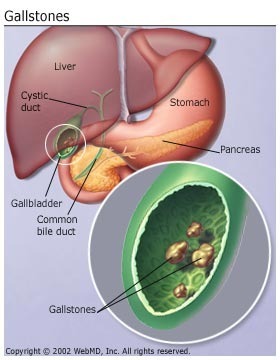
Since my doctor never tried to figure out why my body was making these stones, I had never healed the root cause. The surgery, like a pill to be popped, simply masked the symptom – not healed the problem. Before I found paleo, my health continued to deteriorate for years after the surgery.
Instead of discussing alternate diets that might help (like gluten-free), I had been told I needed to have surgery. I was also told it wouldn’t affect my long-term health and that digestion disruption would only happen short-term. The only truth I had been told was that it would be an “easy” laproscopic out-patient surgery.
After the surgery, I no longer had intense (worse than child birth) painful gallbladder attacks. I’d say “Yipee!” except, instead I was left with the inability to control my bowel movements. Turns out a permanent state of IBS years after a Cholecystectomy is “normal”.
It wasn’t until a few years later, when I discovered the paleo diet, that I’d remember what normal bowel movements felt like. Honestly, the freedom to eat in public without shame or fear of needing to immediately use the bathroom is one I try not to take for granted. Paleo gave me my health and life back with weightloss, but the resolved medical conditions are what I’m truly grateful for.
My recommendations, based on my experience and research:
So how did I get to feeling normal again? Since I had to figure this out on my own with lots of personal experimentation, here’s my experience with what my gallbladder-less body needs:
Beyond the normal paleo diet, I went on a strict autoimmune protocol as outlined in Practical Paleo . Then, I later reintroduced foods to see which caused me a reaction. That means no grains, legumes, dairy (yes, even butter), nuts, seeds, nightshades (tomatoes, potatoes, peppers, eggplant), or eggs. I learned egg whites cause a violent digestive distress for me, whereas nuts and dairy cause skin irritation and joint pain. Every person’s body is different – but, if you or someone you know has Cholelithiasis then it’s likely being caused by a food intolerance and an elimination diet will help them figure out
I cannot do ketogenic diets. Occasional high-fat meals are fine, but since my body no longer is able to properly digest fat I need the carbohydrate and protein balance to help digestion be optimized. I find that around 75g of carbs a day helps me maintain weight, while preventing those IBS-like symptoms caused from my body’s inability to digest fat.
I cannot intermittent fast. Since the gallbladder’s job is to store up bile and release it when needed, huge meals or meals after a long fasting period no longer provoke the release of extra bile. My body no longer has the “ammunition” needed to digest food properly. If an accidental fast happens, I find that grazing for a longer period of time works better as an introduction meal.
I no longer drink a lot at meal times. Since drinking fluids dilutes the stomach acid my body does have, I limit my meal time drinks to just a small glass if needed. And when I do drink, I make sure I have no food in my mouth. This ensures I’m properly chewing my food.
I take Ox Bile and HCL supplements with every meal, which mimic what my gallbladder used to do for me. It’s not quite the same as my own body would be, and since I’m not a doctor I won’t tell you what brands or how much, but these have made a huge difference. What I’ve noticed is less cravings when I take them, which means my body’s able to more easily absorb the nutrients I’m giving it with healthy nutrient-dense meals.
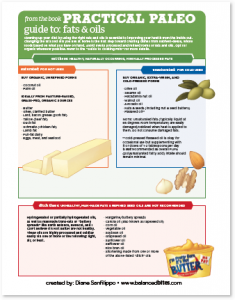 I eat and drink gut healing foods. It’s not enough to try to do damage control on the front end. The more I do to help heal my gut of the food intolerance I had, which created the gallbladder disease, the better my digestion is. I find that kombucha in the morning is my favorite form of probiotics, since the insoluble fiber of raw vegetables can be difficult to digest. I also add organ meats to our meals where I can and make sure to have bone broth at least several times a week.
I eat and drink gut healing foods. It’s not enough to try to do damage control on the front end. The more I do to help heal my gut of the food intolerance I had, which created the gallbladder disease, the better my digestion is. I find that kombucha in the morning is my favorite form of probiotics, since the insoluble fiber of raw vegetables can be difficult to digest. I also add organ meats to our meals where I can and make sure to have bone broth at least several times a week.Most importantly, I only eat fats my body can digest. This means that animal fats are from pastured animals, since grain-fed animals (and egg yolks) can trigger a reaction for me when I digest it. It also means I stick to the Balanced Bites ranking of common cooking fats. Since exclusively cooking with coconut oil, palm oil, palm shortening, lard, bacon grease, duck fat, tallow and butter – my digestive health has never been better!
Learning the differences between oils and fats, why they’re different and how a person’s body responds to them at the Practical Paleo Seminar changed my perspective on what an important piece of the puzzle it was to my health. After that day I started paying close attention to the foods that I ate, how my gut reacted, how my digestion was and ultimately if excretion was “normal” after.
After years on a Paleo diet post-Cholecystectomy, I’ve finally learned how to optimize my digestion. Most importantly, and what no doctor ever told me, is that it is with proper digestion that health and wellness is achieved. If you or someone you know has gallbladder disease or already has their gallbladder removed, Paleo is absolutely a wonderful approach for them.
FAQs
Since the basis of these recommendations goes against conventional wisdom and likely the opposite of what doctors are saying, let’s cover some Frequently Asked Questions.
Q: My doctor says the Paleo diet is too high-fat to be gallbladder-friendly; he says I should go on a vegetarian diet. How can I possibly digest all the fat properly?
A: First of all, the Paleo diet doesn’t have to be high-fat. There are plenty of paleo foods that are naturally low-fat. I ate chicken breasts, salads and steamed veggies my first few months I went Paleo out of fat-phobia. So, until you’re comfortable go ahead and do that. Chris Kresser also addressed this here.
I think it’s easier to avoid sugar and get proper nutrients into you when eating fat, but you’ve got to figure that out yourself. When you’re ready, slowly add in the recommended fats from the Balanced Bites chart above and see how you feel. I found a proper carb-fat-protein ratio that’s ideal for my body; I know because my digestion is fantastic for the first time in years since having gallbladder issues!
Second of all, I was a vegetarian for 7 years. This was the period of time directly before my gallbladder became diseased. My mother was also a vegetarian for nearly a decade, and it was during this time that her gallbladder was diseased. Interestingly, broth was one of the few foods we could eat without triggering painful attacks. Makes sense to us now that we know how great bone broth is for healing the gut!
Q: You’re saying Cholelithiasis is a symptom of something else wrong, not the cause of health problems? What science backs this up?
A: Here’s a link to the GallbladderAttack.com stating food allergies are a common cause of the disease.Here’s a link to Robb Wolf talking about how removal of the gallbladder leads to Dysphagia and other long-term health issues if the cause doesn’t get treated. Here’s a link to Robb Wolf talking about gallbladder removal and autoimmunity, and another about Celiac disease and gallbladders. And then this,this, and this out of PubMed.
Q: When you say “digestive distress” what do you mean? What are some of the things that can happen after surgery?
A: I mean loose, painful, and violent stools unable to be controlled (must-go-now) bowel movements. UsePractical Paleo’s “Poop Pageant” to see if your stools are “fatty” looking (malabsorption of fat) or less than ideal. This is what happened years after surgery; weeks after surgery the situation was so awful and uncontrollable that I (literally) didn’t leave the house for fear of not making it to the bathroom.
Q: How can you reverse the inflammation and gallstones once you start to get them? Is that even possible?
A: I have heard that it is. Since I found the Paleo diet and lifestyle after my gallbladder had already been removed, it’s never been something I looked into. However, several people commented on this postsaying that NDs can sometimes help with supplements. If it were me, I’d get plenty of sunshine and Vitamin D, get plenty of rest, gentle exercise and follow the 7 steps above.
Q: What can I do if I’m still having issues with digestion? Is this going to be forever?
A: Work with a professional! If you’ve done everything in this post and still are struggling, take the time, energy and money and invest it in what matters – your health. Someone like Liz Wolfe or Diana Rogers can help you determine what you might be missing in your approach that could be the key to solving your health issues. Undiagnosed Celiac Disease or other autoimmune conditions can have severe long-term health problems (cancer), so figuring out the issue and resolving it today is worth the investment it will take on your part. That’s what I did, and have been thankful ever since!
 Stacy Toth is the co-blogger at PaleoParents.com. She and her husband, Matt, lost over 200lbs adopting a paleo lifestyle. They have 3 young boys and blog about a practical and affordable approach to feeding their family real food. Their bestselling kid-friendly cookbook, Eat Like a Dinosaur, was published earlier this year. Stacy also co-hosts the well reviewed podcast,The Paleo View, and blogs about her emotional struggles and successes going paleo. You can find them on Facebook, Twitter, Pinterest and Instagram.
Stacy Toth is the co-blogger at PaleoParents.com. She and her husband, Matt, lost over 200lbs adopting a paleo lifestyle. They have 3 young boys and blog about a practical and affordable approach to feeding their family real food. Their bestselling kid-friendly cookbook, Eat Like a Dinosaur, was published earlier this year. Stacy also co-hosts the well reviewed podcast,The Paleo View, and blogs about her emotional struggles and successes going paleo. You can find them on Facebook, Twitter, Pinterest and Instagram.
Photos from WebMD, in accordance with the Use of Content policy.
November 29, 2012
Podcast Episode #63: Dizziness, adrenal fatigue, Tourette Syndrome, HCG Diet

Remember – If you’re enjoying these podcasts, please leave us a review in iTunes. Thanks!
Episode #63: Dizziness, adrenal fatigue, Tourette Syndrome, HCG Diet
UPCOMING EVENTS:
FREE Practical Paleo book signing with Q&A:
SATURDAY, December 1, Summit, NJ - at Lululemon Athletica on Springfield Ave.
Balanced Bites Workshops: 2013 schedule coming soon!
Remember that all events are open to the public, you do not need to belong to the hosting gym to attend!
Opening chat:
Updates on projects, events, and a few words on nut butter consumption and acne.
Topics:
1. Dizzy since a Paleo Challenge? [9:00]
2. Dizzy, could it be adrenal fatigue? [19:30]
3. Tourette Syndrome [30:45]
4. HCG Diet [36:05]
5. Gut healing [47:20]
Show Links:
Mary Vance’s post on HCG
How to Eat, Move, and Be Healthy – Paul Chek
Some of Liz’s supplement picks: Probiotic, Bile salts, Enzymes, General healing
Click here to download this episode as an MP3.
The episodes are currently available in iTunes, Stitcher & Blog Talk Radio.
1. Dizzy since a Paleo Challenge?
June says,
In the past month I have had mild bouts of dizzyness. It’s on and off…I notice it when I wake up and go from supine to vertical or sometimes vice versa, or during the day when I do same…I’m a Pilates trainer so am often demonstrating exercises to clients. It’s not all the time and there doesn’t seem to be any particular pattern. I had this about 3-4 weeks ago. My chiropractor said I had a virus. He gave me herbal supplements. It went away. Now it’s back. I feel like maybe I COULD have a virus….I don’t feel fabulous….I’m tired and my head feels like it’s in the clouds, though I”m not dizzy at the moment, but I was last night. The dizzyness is fleeting and it’s not debiliating….but noticable and annoying cause it’s not supposed to be there. Could this be a deficiency? Have you heard of this w/ Paleo?
I have been strictly Paleo for 6 weeks. My CrossFit gym is doing a 6 week Paleo Challenge which really helped me fine tune and get off sugar….before that, mostly Paleo for about 6-8 months. I’ve never felt better. I’m going to be 60 in January and am told I look 40 (thanks partly to my hair guy, partly to genes, partly to healthy diet and lifestyle). I’ve been gluten free for 7 years. I went gluten free to help my son who needed to try gf. I found it was so beneficial for me I never went back. I cut out most grains last September and dairy in January 2012. Sugar has been my nemesis, but now am sugar free as well.
I am currently strictly Paleo. Breakfast might be some kind of egg dish, or fried eggs, w/ bacon or sausage, avacado, fermented carrots (I’m mostly following your fat loss meal plan…not verbatum but trying to eliminate nuts, too much avacado, yams, etc for now. I could lose about 10-15#-ish. No snacks, breakfast holds me for 5 or more hours. Lunch would be some kind of meat and vegies….maybe salaad w/ steak or chicken, or maybe leftover dinner…yesterday lunch was chicken curry and an apple streusel muffin. Dinner was stuffed cabbage and sauteed greens. Apple for dessert. I’ve cut way back on fruit since sugar is an issue for me.
Last week I decided to have a bowl of pumpkin ice cream. MAN DID I PAY FOR THAT!!
BAD idea. I’ve also found that chocolate gives me a stomach ache…sweetened or not.
I occasionally use honey in my coffee. I drink a cup of decaf less then once a day…probably 4-5 times per week, w/ coconut milk.
Supplements- Designs for Health twice daily multi, 2 Omega 3, 2x per day, Vitamin D3 (my levels are normal…just got checked), Vit. E, 2 per day, Cal Mag (though I’m learning that I don’t really need it due to the amount of vegies I”m eating, and may not be absorbing what I take in cap form). I take my supplements AM w/ breakfast and PM before bed. I take .125mg of synthroid for hypothyroidism. Just had my tsh checked and it’s normal. I’ve never had dizzyness around thyroid issues and feel pretty normal in all other thyroid areas. (I took Armour thyroid for years and a few years ago it “stopped working”…so my doc (who never asks what I’m eating) suggested I go back to synthroid.
For exercise, I do CrossFit 3x per week. I teach 2 Pilates mat classes during the week(where I am doing many of the exercises w/ the class) and take one class from another trainer. I also am demo’ing Pilates exercises throughout the day to clients (I own a studio in El Cerrito).
I walk my dogs for 20-30 minutes once sometimes twice a day, at a “strolling” kind of pace. I don’t enjoy running though sometimes we do at Crossfit. The cardio I get is at CrossFit. I’m comfortable w/ the amount of exercise I get.
I really try to get at least 7 or more hours of sleep, but it’s often 6-7. It’s hard to function w/ 6, but sometimes I just can’t get to bed early enough. I know I can do better in the sleep department.
2. Dizzy – could it be adrenal fatigue?
Hi Diane and Liz,
I love your podcast! Thank you so much for not only giving out such solid information, but doing so in an incredibly down-to-earth manner. I really enjoy listening
I guess I should start with my question, and then get into the details: I generally feel pretty good throughout the day, but I often get spells of lightheadedness, slightly blurred/unable to focus vision, and even vertigo-like imbalance (mild, not severe). This mostly happens either when I am sitting and concentrating for long periods of time (working at my desk, long drives) or even when I am out running. I also get occasional chest tightness/mild pain. I do not feel so dizzy or have fainting spells that I feel unsafe, but I am still concerned. This has also been going on for years. About 3 years ago I felt similarly and went to the doctor. They took my pulse when I was lying down (I have a slightly below average resting heart rate) and then when I stood up my pulse SKYROCKETED. They said this was because I was “severely dehydrated” and put me on an IV. Ever since then I have worked to make sure I drink enough water, cut down my coffee consumption (8-16 oz / day, vs sometimes 4-5 cups) but I still get these sensations almost daily. Until now, I have learned to live with them an have remained unconcerned (figured maybe it was due to stress?).
That is until I began learning about Paleo and some of the symptoms the diet can help with. I began learning about Paleo for lifelong health reasons, but after reading about Adrenal Fatigue I began to question whether that is what I have been experiencing. While I do not showcase all of the symptoms, the ones I do have seem to fit, and I was especially struck when I read about the differences in blood pressure when standing vs sitting vs lying down in relation to adrenal function.
So my questions are: does this seem like adrenal fatigue? Could it be purely dehydration as my doctor suggested? If it is adrenal, how should I go about FINALLY feeling better?
Thank for all you do, Sophie
3. Tourette Syndrome
Michelle says,
For the past six weeks I’ve become obsessed with learning as much as possible about the reasoning and research behind the Paleo diet, and also unlearning the “conventional wisdom”. My husband and three kids ages 9, 12, and 13 eagerly followed along as I transformed our kitchen (but only because I told them they didn’t have to–reverse psychology never hurt anyone), and we all look and feel better as a result. I picked up my first two copies of Practical Paleo at Costco after about three weeks in, and have since purchased three more to give away. It is such a terrific resource and makes it easy to help my friends clean up their own lives. Thank you.
My question is about Tourette’s Syndrome. I have heard bits and pieces about helping Tourette’s through diet, but nothing really substantial. So my question is: Do you have any resources for helping a child with Tourette’s? I can only imagine there must be a huge correlation between diet and this neurological issue, but can’t find more than bits of data. I convinced my sister-in-law and her family to give Paleo a try for thirty days because my 12 year old nephew has Tourette’s (since about age 7) and some ADHD issues. They have resisted medication so far, but their doctor is useless. His only suggestion is to wait it out–that he might grow out of it. While that might be true, it doesn’t really help them right now. Switching his diet seems the most logical first step, and he’s been doing great for almost two weeks now (I bribe him!) The rest of their family knows they will not go back to their old habits because they see huge benefits in onl y a few days, but my nephew has a really strong sugar addiction and is really concerned about Halloween, and can’t wait until the 30 days is over. They notice that many of his ADHD symptoms are better and that he is more calm and focused, but his tics are still the same. I know that if his tics start to subside even minimally he will be motivated to continue, so any tips you can give us would be super helpful. He has eggs and sausage or bacon for breakfast, rolled lunchmeat, fruit, and carrots and maybe some nuts for lunch, and snacks and dinner is usually a recipe from Practical Paleo (they LOVE the book!) He’ll smell the doughnuts the Sunday School teacher brings in, but eats an apple instead, but only because he thinks he’ll be able to eat doughnuts again when the 30 days are up. No supplements yet.
4. HCG Diet
Suzanne says,
I recently ran into a friend who went on the ‘HCG diet’ last year. She confided in me that she hasn’t had a period in six months and feels that there may be a connection to the HCG ‘supplement’. It’s been over 12 months since she was on this program and has since regained a little weight back. (I’d say she’s within a healthy/ideal body composition. Perhaps slightly higher body fat % then ideal). As far as I know, she consumes a nutrient dense, whole foods diet with limited consumption of potential damaging foods. She does yoga as her main form of movement, no chronic cardio here.
As a nutritional consultant, I can not wrap my head around this ‘diet’. Just another quick fix? How did we get so disconnected? Where’s the intuition here? I digress…
I am shocked, actually with my peers and other health practitioners that have embraced and promoted this diet. Of course you’re going to lose weight on 500 calories a day, But at what cost? What are the potential long term ramifications of this diet? on our metabolism? endocrine health? Any derangement going on here? I apologize if you’ve already covered this. I could not find it in a search. But if you would, I’d love to hear your thoughts on this one. As always Ladies, keep up your amazing work and spreading the good word. You are inspiring more than you know!
Thanks, Suzanne
PS. Diane, Practical Paleo has become an invaluable tool for me and my clients
Liz- I look forward to your upcoming book too!
5. Gut healing
Madison says,
Hello! I have a question for you today about 3 things regarding the paleo diet, but I’ll make each one of them as short as possible!
Okay, here are my questions:
1. I want to try paleo because I feel like grains like quinoa is still bothering my stomach. I’m worried about getting enough to eat though, because many paleo foods are off limits for me. I can’t eat eggs, vegetables like broccoli, cauliflower, peppers, sweet potatoes bother my stomach (beans also hurt it, but that’s okay because paleo doesn’t include those anyways)… and I can’t digest fat. Seriously. Whenever I eat any type of nut, avocado, coconut, oil, or even tuna (with a small amount of fat– like 1 gram!) my stomach starts getting bubbly and rumbling. I usually get stomach pains shortly after and have terrible gas for days. I know that fat is very important, and I take flaxseed oil (about 3 grams of fat worth daily) and digestive enzymes (because I have a lipase deficiency) with every meal to help me cope. Still no fat. Will my fat digestion improve after going Paleo? What are some things that I can do to help me digest these foods properly?
2. My naturopath said that I have candida, which I’m sure you get a lot of questions about. She wants me to go on a basic Atkins diet, which I think would be even tougher for me than paleo because of the high levels of fat. Have you heard of anyone having success with candida and a paleo diet? Any tips?
3. My dream would be to one day be able to eat some of the foods that I was allergic to again. Do you have any inspirational stories of people reversing, or improving their food allergies from going paleo.
Thanks for taking the time to answer my questions!
Backstory: I took antibiotics for my acne for 4 years and severely messed up my stomach. Now I’m allergic to wheat, eggs, milk, peanuts, tomato, celery, rye, pork, yeast (in yogurt) and probably something else, but I can’t remember right now! Haha. I was suffering from severe stomach cramps, pain, bloating, weight gain, fatigue, nausea. It all started suddenly last December and after finally finding a naturopath who could help, I’m feeling better. I am currently taking probiotics, adrenal caps, magnesium, buffered vitamin c, choline, digest (a digestive enzyme) and allergy drops. The only things that I eat that are non-paleo are quinoa flakes, stevia, and brown rice protein powder.
Exercise wise, I walk a lot and do some toning exercises a few times a week. The last time that I tried to run and do heavy-cardio work I actually gained weight and was craving carbs all of the time. I gain weight really easily!
I sleep normally. I don’t have a problem with sleeping, but as a college student (aged 18) I could probably go to bed a little earlier!!
Basic day of food… I know it includes grains. That’s why I am thinking of shifting!
Breakfast: Banana, protein powder, quinoa, pure stevia (digestive enzyme, vitamin c, adrenals, magnesium, choline, flaxseed)
Lunch: tuna, lettuce, cucumbers, grapes, green beans (digestive enzyme, flaxseed, choline, adrenals)
Snack: apple, quinoa, pure stevia
Dinner: grilled chicken, steamed zucchini, lettuce, grapes, cucumbers (sometimes, but rarely rice) (digestive enzyme, choline, flaxseed)
Snack: quinoa and pure stevia, fruit (digestive enzyme, vitamin c, probiotics-50)
Click here to submit questions.
Cheers!
Diane & Liz
November 20, 2012
2012 Healthy Holiday Gift Guide
The holidays are nearly upon us, so now’s the perfect time to start scoping out all of those fantastic gift ideas for your loved ones this season.
You may also want to check out my guides from 2011 and 2010 as they’re also chock full of ideas and goodies!

Practical Paleo: A Customized Approach to Health and a Whole-Foods Lifestyle
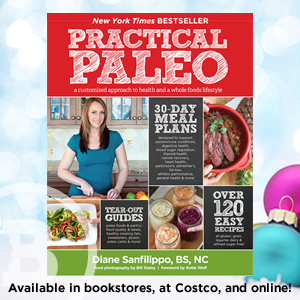
I couldn’t possibly make gift-guide recommendations for this year without putting my own baby up-front-and-center, could I?! Whether you are buying for a seasoned Paleo-eater, or hoping to introduce someone to this new lifestyle, my book balances the science of how food works in the body with the practical/how-tos of eating grain-free every day. As a best-selling book, you better believe that the buzz is huge about how many people now recommend Practical Paleo as the go-to, #1 book they recommend for folks interested in learning all about Paleo, and the over 120 recipes are nothing if they’re not easy and delicious enough to please even the most stubborn palate!
Grab a copy of Practical Paleo in bookstores, at Costco, or online via Amazon.com.

Michael Symon’s Carnivore: 120 Recipes for Meat Lovers
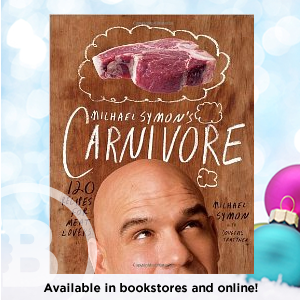 Chef Michael Symon’s new book focuses on one of my favorite things in the world – meat. While this book isn’t exclusively Paleo, the recipes will be easy enough to adapt and will open you up to some new ideas. It’s awesome to get Paleo-oriented cookbooks that are being released with new recipes, but don’t forget that there are lots of great books out there that will still fall within the realm of real food that aren’t necessarily titled as “Paleo.” I know that Chef Symon doesn’t eat crap (check out his T-shirt here, courtesy of The Food Lovers Kitchen!), so I can get on board with recommending his new book!
Chef Michael Symon’s new book focuses on one of my favorite things in the world – meat. While this book isn’t exclusively Paleo, the recipes will be easy enough to adapt and will open you up to some new ideas. It’s awesome to get Paleo-oriented cookbooks that are being released with new recipes, but don’t forget that there are lots of great books out there that will still fall within the realm of real food that aren’t necessarily titled as “Paleo.” I know that Chef Symon doesn’t eat crap (check out his T-shirt here, courtesy of The Food Lovers Kitchen!), so I can get on board with recommending his new book!
Grab a copy of Carnivore in bookstores or online via Amazon.com.

Real Food Fermentation: Preserving Whole Fresh Food with Live Cultures in Your Home Kitchen
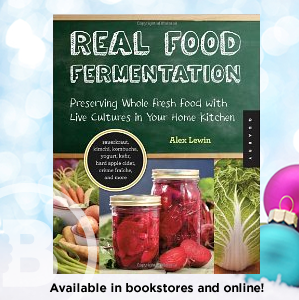 Lots of you are taking to the idea of home fermentation, and while this book once again does not have a Paleo focus, you can take the information, techniques, and concepts within it and apply it to foods you eat regularly. I love the idea of being able to make any flavor or kraut, kombucha, or other fermented vegetable you like – this book will help you do just that.
Lots of you are taking to the idea of home fermentation, and while this book once again does not have a Paleo focus, you can take the information, techniques, and concepts within it and apply it to foods you eat regularly. I love the idea of being able to make any flavor or kraut, kombucha, or other fermented vegetable you like – this book will help you do just that.
Grab a copy of Real Food Fermentation in bookstores or online via Amazon.com.
You could also DIY and make your friend or loved one some homemade sauerkraut! YUM!

Real Bone Broth
 I’ve been yapping on about the benefits of bone broth (or stock, as the rightly educated call it – though I just like how broth sounds better, so there…) for a long time now. I posted my Mineral-Rich Bone Broth recipe back in April of 2011, and since then it’s been one of my busiest blog posts to-date. Most of you have realized how easy it is to make, especially in a slow-cooker, and have taken to the habit of preparing batches of it weekly – or even more often – and love the process and the results. But I know that many of you still wish you had more time to consider it, or had a way of simply ordering it to keep on-hand for an in-a-pinch situation. So, while making broth or stock is about as easy as boiling water, I wanted to pass along this fantastic resource I found while at the 2012 Weston A. Price Foundation Wise Traditions Conference.
I’ve been yapping on about the benefits of bone broth (or stock, as the rightly educated call it – though I just like how broth sounds better, so there…) for a long time now. I posted my Mineral-Rich Bone Broth recipe back in April of 2011, and since then it’s been one of my busiest blog posts to-date. Most of you have realized how easy it is to make, especially in a slow-cooker, and have taken to the habit of preparing batches of it weekly – or even more often – and love the process and the results. But I know that many of you still wish you had more time to consider it, or had a way of simply ordering it to keep on-hand for an in-a-pinch situation. So, while making broth or stock is about as easy as boiling water, I wanted to pass along this fantastic resource I found while at the 2012 Weston A. Price Foundation Wise Traditions Conference.
Note: I NEVER recommend boxed or canned store-bought stocks/broths, even in a pinch! They are not healing, nourishing foods and are not worth your hard-earned money. The recommendation above is the REAL DEAL!
Buy Real Bone Broth (and a bunch of other real food goodies) online at Wise Choice Market.

Honest Potato Chips
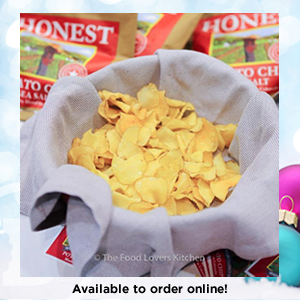 Don’t say I didn’t warn you… these chips are amazing! While some Paleo folks freak out at even the mention of a white potato, I hesitate to believe that they’re the cause of metabolic issues for most folks. That said, I tasted these at the Wise Traditions Conference (noticing a trend here?!) and fell in love at first bite. While I wouldn’t want these around my house every day because the risk of over consumption would just bee too high, I think they’re the best real-food-friendly chip I’ve found outside of any you can make at home in duck fat, lard, or tallow. Fried up in coconut oil, these lightly salted, crispy chips are a fantastic gift and would also be perfect to plate up for a holiday party along with a home made dip!
Don’t say I didn’t warn you… these chips are amazing! While some Paleo folks freak out at even the mention of a white potato, I hesitate to believe that they’re the cause of metabolic issues for most folks. That said, I tasted these at the Wise Traditions Conference (noticing a trend here?!) and fell in love at first bite. While I wouldn’t want these around my house every day because the risk of over consumption would just bee too high, I think they’re the best real-food-friendly chip I’ve found outside of any you can make at home in duck fat, lard, or tallow. Fried up in coconut oil, these lightly salted, crispy chips are a fantastic gift and would also be perfect to plate up for a holiday party along with a home made dip!
Buy Honest Potato Chips directly from the company online.

Kombucha Starter SCOBY & Glass Jars
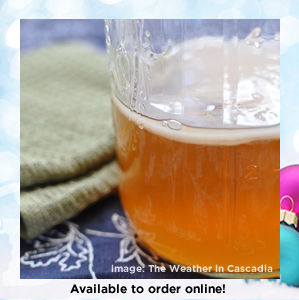 If you have the bug (get it, bug?!) to start making your own home-brewed kombucha, here’s your chance. Whether you’re tired of paying $3-4 a bottle for a store brand, or you just want to play around with science experiments in your kitchen, there are lots of options for getting your own SCOBY (symbiotic colony of bacteria and yeast). I’m linking to three I found online, but I don’t have personal experience with any of them. I don’t think it matters much where you get the SCOBY, you just need to follow instructions to keep it alive and brew your tea. I was lucky enough to get the few I’ve needed as starters from friends, so once yours begins to grow and reproduce (these things are sorta like Grelmins, so watch out!), you will be able to share the SCOBY-love with your friends within just a few weeks!
If you have the bug (get it, bug?!) to start making your own home-brewed kombucha, here’s your chance. Whether you’re tired of paying $3-4 a bottle for a store brand, or you just want to play around with science experiments in your kitchen, there are lots of options for getting your own SCOBY (symbiotic colony of bacteria and yeast). I’m linking to three I found online, but I don’t have personal experience with any of them. I don’t think it matters much where you get the SCOBY, you just need to follow instructions to keep it alive and brew your tea. I was lucky enough to get the few I’ve needed as starters from friends, so once yours begins to grow and reproduce (these things are sorta like Grelmins, so watch out!), you will be able to share the SCOBY-love with your friends within just a few weeks!
Goldfinch Kombucha SCOBY via Amazon.
Kombucha Mamma SCOBY via Amazon.
Kombucha Brooklyn Home-Brew Kit via Amazon.
Oregon Kombucha Complete Starter Kit (Black Tea) via Amazon.
1-Gallon Anchor Hocking glass jars (I use these) via Amazon.
Case of 12 glass bottles for kombucha (or save & re-use ones you get from the store!) via Amazon.

OXO Good Grips V-Blade Mandoline Slicer
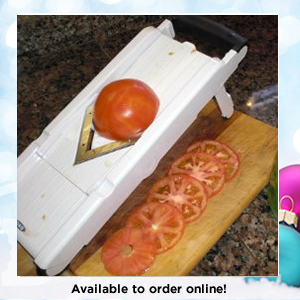 Wondering how restaurants get those perfectly thin slices of potato for their house-made chips? Or trying to make waffle fries but can’t seem to get it right on a box grater – oops! A mandoline is the tool you need! Don’t forget to grab a Metal Mesh Glove (see below) to accompany this bad boy, or you may not end up using it as much as you think for fear you’ll slice off your fingerprints!
Wondering how restaurants get those perfectly thin slices of potato for their house-made chips? Or trying to make waffle fries but can’t seem to get it right on a box grater – oops! A mandoline is the tool you need! Don’t forget to grab a Metal Mesh Glove (see below) to accompany this bad boy, or you may not end up using it as much as you think for fear you’ll slice off your fingerprints!
OXO Good Grips Mandoline Slicer on Amazon.
Metal Mesh Glove
Have you fallen victim to your mandolin slicer’s blade one too many times?

Once is enough – or never! Use this handy tool (get it, handy?!) when running that taro or yucca root across the blade for those thin chips you’re about to toss in duck fat and bake (or fry!) and keep your digits safe and sound.
Microplane Kitchen Cut-Protection Glove on Amazon.

Tri-Blade Plastic Spiral Vegetable Slicer
 Last year one of my top picks was a julienne peeler, which I stand by as a recommendation, however, I think this gadget might really be one-upping the hand-held tool. Make quick work of creating zucchini noodles (fit for recipes out of books like Practical Paleo and Make it Paleo), or noodles/spiral-cut-justaboutanything…! I imagine some of you will grab one of these for your own kitchen, and I invite anyone to bring one to my forthcoming housewarming party, because I need one, too!
Last year one of my top picks was a julienne peeler, which I stand by as a recommendation, however, I think this gadget might really be one-upping the hand-held tool. Make quick work of creating zucchini noodles (fit for recipes out of books like Practical Paleo and Make it Paleo), or noodles/spiral-cut-justaboutanything…! I imagine some of you will grab one of these for your own kitchen, and I invite anyone to bring one to my forthcoming housewarming party, because I need one, too!
Tri-Blade Plastic Spiral Vegetable Slicer on Amazon.

Global 3-Piece Knife Set
 Several years ago this knife set was given to me when I started my organic meal delivery business – and what a game-changing day that was! I admired these knives in the hands of chefs like Giada De Laurentiis for years on the Food Network, but somehow managed only to use the random chef’s knife I found here or there for some kind of great bargain. Little did I know that a good knife set can last many more years than one that’s less expensive if kept well, honed regularly, and sharpened when necessary. Enjoy this set for yourself, or gift it to someone new to cooking – but maybe send them a Metal Mesh Glove as well, for the other hand just in case!
Several years ago this knife set was given to me when I started my organic meal delivery business – and what a game-changing day that was! I admired these knives in the hands of chefs like Giada De Laurentiis for years on the Food Network, but somehow managed only to use the random chef’s knife I found here or there for some kind of great bargain. Little did I know that a good knife set can last many more years than one that’s less expensive if kept well, honed regularly, and sharpened when necessary. Enjoy this set for yourself, or gift it to someone new to cooking – but maybe send them a Metal Mesh Glove as well, for the other hand just in case!
Global 3-Piece Knife Set on Amazon.

Paleo Power Socks
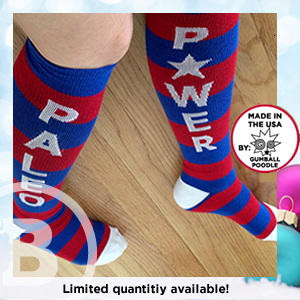 These socks are 75% cotton, 20% polyester, 5% spandex, and 100% awesome. They are thick enough to protect you from the whip of a missed double-under, and have enough staying power to keep themselves up through even the longest chipper of box jumps and toes-to-bar.
These socks are 75% cotton, 20% polyester, 5% spandex, and 100% awesome. They are thick enough to protect you from the whip of a missed double-under, and have enough staying power to keep themselves up through even the longest chipper of box jumps and toes-to-bar.
Machine washable. Instructions say hang to dry, but I always toss mine in the dryer!’
Made in the USA by Gumball Poodle.
Paleo Power socks are available for ordering for a limited time.

Super Simple Sugar Scrub (DIY)
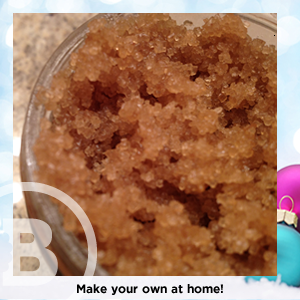 Homemade sugar scrub is fantastic for any occasion – scent it with mint for a foot scrub, or someone’s favorite essential oil for a whole-body bath scrub.
Homemade sugar scrub is fantastic for any occasion – scent it with mint for a foot scrub, or someone’s favorite essential oil for a whole-body bath scrub.
Check out my recipe for Super Simple Sugar Scrub.

Remember, I have a lot more great gift recommendations over in my 2011 and 2010 holiday gift-guide posts that are still going to make this season’s gift-getters smile!
Happy Holidays!
Diane Sanfilippo's Blog
- Diane Sanfilippo's profile
- 52 followers


